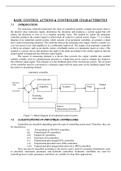Exam (elaborations)
Automatic Control Systems
- Module
- Institution
These set of notes covers the basics as well as advanced course space of automatic control system. It has notes covering topics such as TIME-DOMAIN ANALYSIS OF CONTROL SYSTEMS CONTROL SYSTEM COMPONENTS AND DEVICES STABILITY OF LINEAR CONTROL SYSTEMS. Transfer Function, Block Diagram and Signal...
[Show more]



